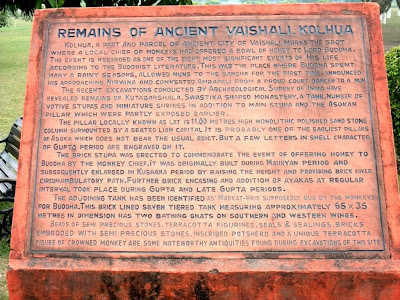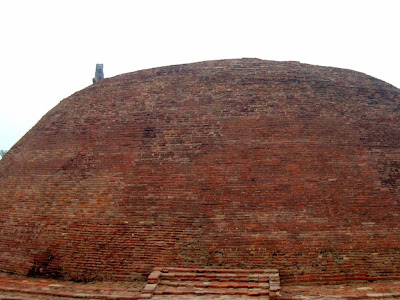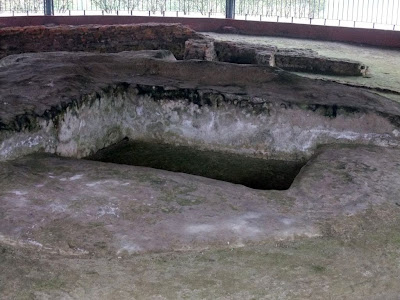
Vaishali is an ancient city in Bihar State of India. The name was derived from an Indian ancient King called Vaishala. It was a highly populated capital city of the vibrant republican Lichchhavi State in 6th century (BC), rich and prosperous with abundant food, at the time during Buddha's occasional visits. It was in fact the first place Buddha visited after he left home to seek the truth for the path of life and also the place where he delivered his last sermons before attaining Maha-parinirvana in year 483 BC. Vaishali became a more important place for Buddhism after King Kalasoka convened the 2nd Buddhist council in year 383Bc which was already 100 years later after Buddha's nirvana.


The brick Stupa of Ananda at Kolhu in Vaishali is the exact location where Buddha delivered his last sermon. Emperor Ashoka erected the pillar at the spot to commemorate the event.


It was said that when Buddha set out for Kushinagar after his last discourse in Vaishali, many Lichchhavis kept following behind him but were finally stopped by a river created by Buddha. The site was identified with Deora in modern Kesariya village where Ashoka Pillar was built later.


The site of Vaishali was first identified by British archaeologist Alexander Cunninghan who based on the diary articles written by Chinese monks Faxian and Xuanzang who traveled the place in 4th and 7th century.


Remains of Monastery Kuta Garasala Vihara where Buddha frequently stayed during the visit to Vaishali. It was said that during one of his visits, The Buddha was offered with honey by monkeys and they also dug out a tank to make his stay comfortable.



The 18.3 meter high Ashoka Pillar built in 3rd century BC, is very well preserved and it is the only complete one left standing on earth.



To circle round the huge Ananda Stupa for 3 times required a little bit more time.



Ashoka pillar is a representative symbol of golden India architecture. It was made from a single piece of red stone, capped by a high bell shaped capital, with a life-sized lion figurine.







Ananda Stupa is huge in size. Ananda was Buddha's notable personal attendant who attained Nirvana in the midst of Ganges out of Vashali.


Sala trees are very common at the site. The flowers of Sala tree were always used as a symbol in the practice of Dharma.



Every where is planted with Sala trees which is a reputable holy plant to Buddhism. Lord Buddha was born under a Sala tree in Lumbini Garden when his mother was on the way back to her home for delivery. It was also recorded that when Buddha attained Maha-parinirvana, two Sala trees were blossom in their non-flowering season. The petals of bloom flowers were like fragrant rains falling softly and gently over his body.



Souvenirs stall organized by local villagers focus mainly on Ashoka pillars.


A view of Kolhua Village


Vaishali is a pilgrim center for Buddhists as well as Jains as Lord Mahavira of Jains was born here.



Relic Stupa was built by Lichchhavis in 4th century BC. to contain the relic of Buddha.


The Relic Stupa of Lichchhavis was a sacred and holy place to all Buddhists. We circled several rounds to pay our highest homage and respect to our greatest teacher, The Buddha.


Lichchhavis Relic Stupa was built with bricks with a casket containing 1/8 of Buddha's relic. After Buddha's death, Lichchhavis received the relics and encased them in the stupa.




There are many beautiful temples within the site, built by different countries.



The colorful local costumes and common breakfast puri (to be taken together with dhal).



Public transport in India are always packed with people.


Sugar cane is the local major produce and people are the main labors at this part of India.


Along the road towards Nepal, you may not only encounter with people packed on the vehicles, some Hindu temples but also scenic way with lines of palm trees, which flowers are used to ferment into alcohol by the locals.



hii,where do u from,nice presentation
ReplyDelete